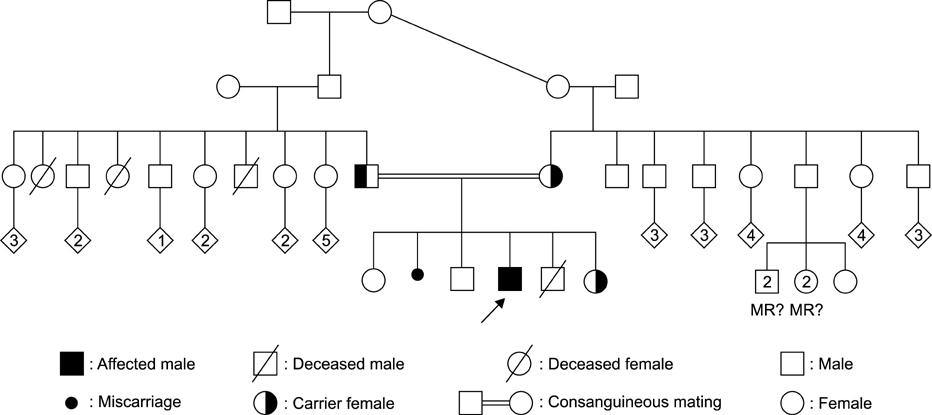Pediatr Gastroenterol Hepatol Nutr.
2017 Mar;20(1):61-64. 10.5223/pghn.2017.20.1.61.
A Rare Cause of Recurrent Acute Pancreatitis in a Child: Isovaleric Acidemia with Novel Mutation
- Affiliations
-
- 1Department of Pediatric Gastroenterology Hepatology and Nutrition, Karadeniz Technical University, Faculty of Medicine, Trabzon, Turkey. muratcak@hotmail.com
- 2Department of Genetics, Karadeniz Technical University, Faculty of Medicine, Trabzon, Turkey.
- 3Department of Pediatrics, Karadeniz Technical University, Faculty of Medicine, Trabzon, Turkey.
- 4Department of Pediatric Endocrinology and Metabolism, Karadeniz Technical University, Faculty of Medicine, Trabzon, Turkey.
- KMID: 2375280
- DOI: http://doi.org/10.5223/pghn.2017.20.1.61
Abstract
- Recurrent acute pancreatic attacks is a rare clinical condition (2-5% of all acute pancreatis) in children and is mainly idiopathic in most cases. Sometimes it may be associated with congenital anomalies, metabolic diseases or hereditary conditions. Isovaleric acidemia (IVA) is a rare autosomal recessive amino acid metabolism disorder associated with isovaleryl coenzyme A dehydrogenase deficiency presenting the clinical findings such metabolic acidosis with increased anion gap, hyperammonemia, ketonemia, hypoglycemia, "the odor of sweaty feet," abdominal pain, vomiting, feeding intolerance, shock and coma. Recurrent acute pancreatitis associated with IVA have been rarely reported. Herein; we report a child who admitted with recurrent acute pancreatic attacks and had the final diagnosis of IVA. Mutation analysis revealed a novel homozygous mutation of (p.E117K [c.349G>A]) in the IVA gene. Organic acidemias must kept in mind in the differential diagnosis of recurrent acute pancreatic attacks in children.
Keyword
MeSH Terms
Figure
Reference
-
1. Kandula L, Lowe ME. Etiology and outcome of acute pancreatitis in infants and toddlers. J Pediatr. 2008; 152:106–110. 110.e1
Article2. Nydegger A, Couper RT, Oliver MR. Childhood pancreatitis. J Gastroenterol Hepatol. 2006; 21:499–509.
Article3. Masamune A, Mizutamari H, Kume K, Asakura T, Satoh K, Shimosegawa T. Hereditary pancreatitis as the premalignant disease: a Japanese case of pancreatic cancer involving the SPINK1 gene mutation N34S. Pancreas. 2004; 28:305–310.
Article4. Suzuki M, Sai JK, Shimizu T. Acute pancreatitis in children and adolescents. World J Gastrointest Pathophysiol. 2014; 5:416–426.
Article5. Pohl JF, Uc A. Paediatric pancreatitis. Curr Opin Gastroenterol. 2015; 31:380–386.
Article6. Mantadakis E, Chrysafis I, Tsouvala E, Evangeliou A, Chatzimichael A. Acute pancreatitis with rapid clinical improvement in a child with isovaleric acidemia. Case Rep Pediatr. 2013; 2013:721871.
Article7. Ozgul RK, Karaca M, Kilic M, Kucuk O, Yucel-Yilmaz D, Unal O, et al. Phenotypic and genotypic spectrum of Turkish patients with isovaleric acidemia. Eur J Med Genet. 2014; 57:596–601.
Article8. The Institute of Medical Genetics in Cardiff. The human gene mutation database [Internet]. Cardiff (UK): The Institute of Medical Genetics in Cardiff;cited 2016 Feb. Available from: http://www.hgmd.cf.ac.uk/ac/index.php.9. Manes G, Uomo I, Menchise A, Rabitti PG, Ferrara EC, Uomo G. Timing of antibiotic prophylaxis in acute pancreatitis: a controlled randomized study with meropenem. Am J Gastroenterol. 2006; 101:1348–1353.
Article10. Minen F, De Cunto A, Martelossi S, Ventura A. Acute and recurrent pancreatitis in children: exploring etiological factors. Scand J Gastroenterol. 2012; 47:1501–1504.
Article11. Kahler SG, Sherwood WG, Woolf D, Lawless ST, Zaritsky A, Bonham J, et al. Pancreatitis in patients with organic acidemias. J Pediatr. 1994; 124:239–243.
Article
- Full Text Links
- Actions
-
Cited
- CITED
-
- Close
- Share
- Similar articles
-
- Isovaleric Acidemia in Siblings Diagnosed by Organic Acid Analysis
- Propionic Acidemia with Novel Mutation Presenting as Recurrent Pancreatitis in a Child
- Continuous Renal Replacement Therapy in a 4-year-old Child with Rhabdomyolysis Following Parainfluenza Virus Infection and Hyperammonemia due to Isovaleric Acidemia
- Chronic intermittent form of isovaleric aciduria in a 2-year-old boy
- Three Cases of Hereditary Pancreatitis in Two Households in the Same Family Associated with R122H Mutation in Cationic Trypsinogen Gene


